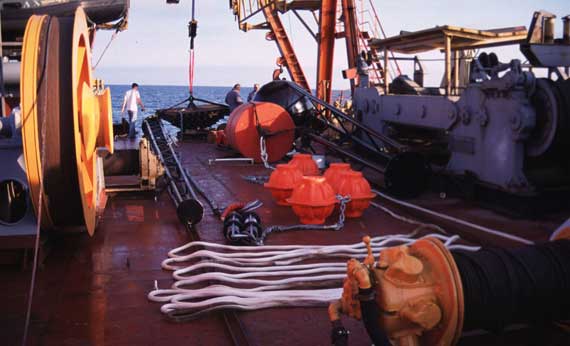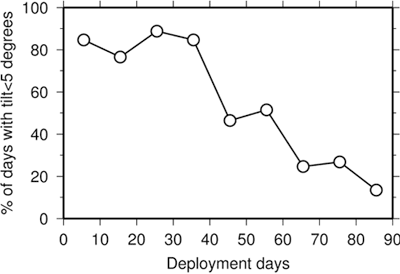The
full-scale beta version was built in spring 2000. The
material was aluminum for minimizing weight. It is made
of two parts, the lower one which is from 20m to 9m below
the surface and consists of the sphere and a simple tubular
structure, and the upper one which goes from 9m below
the surface to 4.5m above the surface, and which hosts
the instrumentation.
The full-scale beta version has been deployed on site
during three months (20 July to 20 October 2000), which
allowed to encounter a variety of meteorological situations.
The buoy was equipped with two inclinometers, a pressure
sensor, an ARGOS beacon and a flashlight. The goal of
this deployment was to qualify the new concept of buoy
as well as to identify possible problems necessitating
modifications. Fig. 7 shows the full mooring on
the deck of the ship before it is deployed. A full day
was necessary for the deployment operations, which as
well are totally new with respect to what is usually
performed for classical moorings. The details of these
operations are not given here.

The complete mooring line on the deck
of the ship, before deployment (beginning of operations
: July 20, 2000 ; 7 am)
Back to top
The results of this deployment are shown in Figs. 8
and 9. Without entering into out-of-scope details, the
following comments can be made (refer to the figure legends):
- From mid-September to the end of the deployment,
the conditions were quite rough (mean swells up to
4m, which means at least 5m peaks).
- Until mid-September,
the periods where the buoy is inclined at angles
larger than 5o is small, which means that
the beta version was already satisfying the requirements
for meteorological conditions from calm to moderate.
- Oscillations are
observed, which exactly match the inertial period
of the ocean at the latitude of the site. These oscillations
are due to oscillations of the water masses after
the wind stress is relaxed.
In summary, the results of the qualification deployment
showed a certain lack of righting torque, with consequences
on the behavior of the buoy when the swell becomes greater
than about 2m. Although not dramatic, this behavior is
not totally satisfactory, so that it was decided to introduce
slight modifications in the design and construction of
the buoy in order to improve the percentage of time for
which the requirements in terms of inclination is satisfied.
Results of the qualification deployment
(July 20 to October 20, 2000), showing the time series
of (a) the depth of the buoy CTD (nominally at 8.3 meters
when the buoy is motionless and the sea surface perfectly
flat), (b) the buoy tilt, (c) the swell height, (d) the
swell period, and (e) the wind speed.

Percentage of the tilt measurements
that were lower than 5 degrees, as computed over successive
decades of the qualification deployment.
Back to top